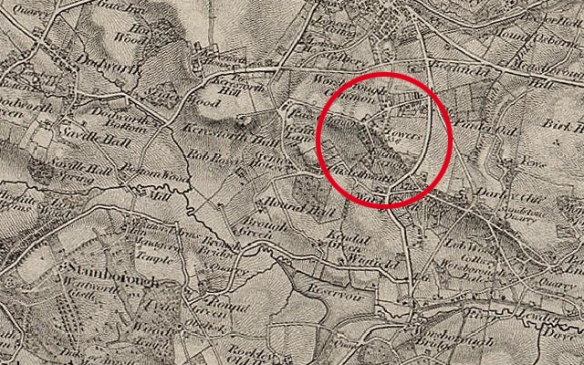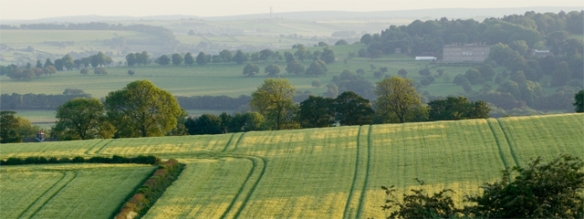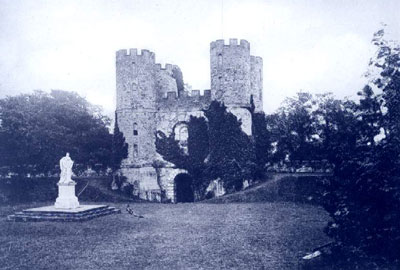 Summer can be the cruelest season for landscape photography. Early sunrises and late sunsets don’t fit comfortably into the modern pattern of life. Sunrise before 5.00am often means rising at 2.00am to be in position on a Pennine hill top to catch the first colours of dawn. Sometimes it can be an exhilarating experience to spend a summer night on the moors waiting for dawn, but it isn’t something that can be done regularly if you have to function like a normal human being and do a day job, resisting the overwhelming urge to fall asleep during the afternoon.
Summer can be the cruelest season for landscape photography. Early sunrises and late sunsets don’t fit comfortably into the modern pattern of life. Sunrise before 5.00am often means rising at 2.00am to be in position on a Pennine hill top to catch the first colours of dawn. Sometimes it can be an exhilarating experience to spend a summer night on the moors waiting for dawn, but it isn’t something that can be done regularly if you have to function like a normal human being and do a day job, resisting the overwhelming urge to fall asleep during the afternoon.
It isn’t unusual for me to deviate a little from my normal approach to landscape photography during the summer months. Often I will use the long daylight hours to visit historical buildings, or scout out new locations. Last year I enjoyed photographing new fern fronds unfolding in our garden, lavender buds bursting into life and butterflies visiting the buddleia. Often a summer project will present itself to me naturally.
This year, springtime had been unusually busy. With a general election approaching I had been frantically producing materials for my local (newly formed) Green party. Once the election was over, my thoughts began to turn back to routing around in the history around me. A walk around the monuments at nearby Wentworth Castle presented me with a new project, but not one that I had expected.
I can see Wentworth Castle from the end of the road that I live on. A wooded hilltop across the valley that has been occupied since at least the Iron Age, now crowned with an 18th century castellated folly. A little further down the slope stands Wentworth Castle, a huge country pile sat on the hillside in all its Georgian splendour. For more about the history of Wentworth Castle, see my earlier post. While researching this, I decided that I needed to have a proper walk around the parkland and explore the monuments.
I parked near the Strafford Arms, walked through Strafford Gate and up the hill to the restored Serpentine Bridge. Following the path along the Serpentine (originally an ornamental river, but now a series of half dried-up ponds) I eventually reached the small patch of woodland, heading for the Rotunda. As I emerged from the woods, there in the field before me was a couple of Fallow Bucks, with Red Deer further down the hill. I was of course immediately smitten! I made a return trip with my camera with the intention of photographing the Serpentine Bridge and Rotunda, it didn’t take much for my attention to turn towards the deer and my summer project was born.

 I returned to Wentworth Castle Park almost every day over the summer. Sometimes walking the dogs, sometimes with my camera but always watching the deer as closely as possible, getting to know their habits and just how closely they would tolerate me. While the fawns were still young, the does were quite jumpy. They would bark their dismay when I drew close and an early lesson in respecting distance was learned when a red doe charged at one of my dogs. Fortunately, there was a big wire fence between us but it demonstrated that these are not just docile, passive animals. They should be respected and given space.
I returned to Wentworth Castle Park almost every day over the summer. Sometimes walking the dogs, sometimes with my camera but always watching the deer as closely as possible, getting to know their habits and just how closely they would tolerate me. While the fawns were still young, the does were quite jumpy. They would bark their dismay when I drew close and an early lesson in respecting distance was learned when a red doe charged at one of my dogs. Fortunately, there was a big wire fence between us but it demonstrated that these are not just docile, passive animals. They should be respected and given space.
There has been a deer park at Wentworth Castle/Stainborough since at least the Elizabethan era and two species of deer inhabit the park. Red deer, which are farmed at Round Green nearby and smaller Fallow deer, which seem to live a more-or-less wild existence. Red deer seem to abide by a herd mentality where as the Fallow deer seem more likely to wander in small groups or individually and are more flighty. Once you get too close for comfort, they will spring away with a bounding grace, where Red deer will just ease out of your way.
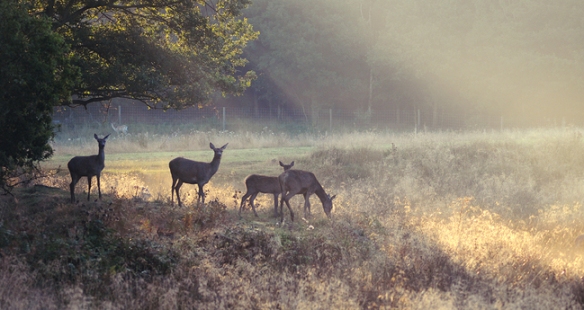
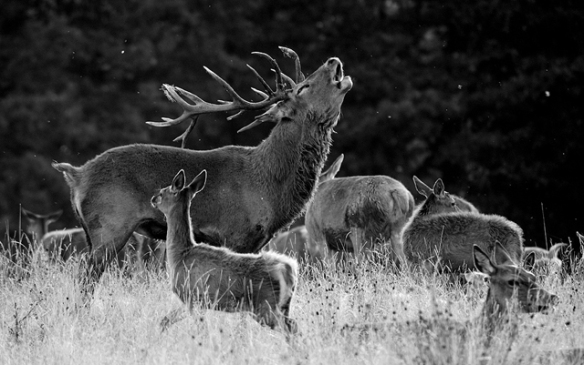 I gradually learned how to get closer. I realised quite early on that trying to sneak up unseen was pointless. Dozens of super-sensitive eyes, ears and noses will know you are there before you even see the herd. I found that giving them time to get used to my presence, while gradually moving forward diagonally produced the best results. Eventually, I found that I could almost walk amongst the herd, although respecting a certain distance is still important and by using a long lens, I don’t need to get too close anyway. There are only so many close-up head-shots that are useful and I prefer to try to capture the deer in their environment. I feel that the wellbeing of the animals is by far more important than getting photos and after a while (usually no more than an hour) I withdraw and let them get on with doing whatever deer do when humans aren’t around.
I gradually learned how to get closer. I realised quite early on that trying to sneak up unseen was pointless. Dozens of super-sensitive eyes, ears and noses will know you are there before you even see the herd. I found that giving them time to get used to my presence, while gradually moving forward diagonally produced the best results. Eventually, I found that I could almost walk amongst the herd, although respecting a certain distance is still important and by using a long lens, I don’t need to get too close anyway. There are only so many close-up head-shots that are useful and I prefer to try to capture the deer in their environment. I feel that the wellbeing of the animals is by far more important than getting photos and after a while (usually no more than an hour) I withdraw and let them get on with doing whatever deer do when humans aren’t around.
As summer turned towards autumn, the foals grew bigger and the does became less jumpy. The stags began to joust as rutting season approached and were becoming too distracted to worry much about me. I was starting to recognise individual animals by this time and have to confess a certain fondness for the biggest stag of the herd, a monarch stag who I nicknamed ‘The Big Feller’. He is an impressive creature with huge antlers and when he throws his head back and lets out his baleful bellow, it makes the hairs on the back of my neck stand up.
Getting close to Fallow deer is a different proposition to the reds and often turns out to be more by luck than judgement. I found that I was more likely to bump into them than follow them, as they favour the areas of mixed woodland and long grass. The bucks seem to be more relaxed than the does and will tolerate you more closely. There are a couple of bigger bucks that once they were in rutting season didn’t seem bothered by human presence in the slightest. In fact they have passed within a few feet of me without concern.

 One occasion left me almost speechless. While photographing a couple of bucks in long grass the large white buck announced himself by crashing through the undergrowth. He and the other large buck began ‘parallel trotting’ (a way to size each other up before fighting) towards me before locking antlers with a ferocity that belies their cute appearance. These animals are 200lbs of pure muscle with antlers attached to the front, that bear a close resemblance to medieval weaponry. They were so close that at one point I had to jump out of the way! It was an exhilarating experience.
One occasion left me almost speechless. While photographing a couple of bucks in long grass the large white buck announced himself by crashing through the undergrowth. He and the other large buck began ‘parallel trotting’ (a way to size each other up before fighting) towards me before locking antlers with a ferocity that belies their cute appearance. These animals are 200lbs of pure muscle with antlers attached to the front, that bear a close resemblance to medieval weaponry. They were so close that at one point I had to jump out of the way! It was an exhilarating experience.
There is something about deer, stags in particular that strikes a deep chord within me. During the Mesolithic period, the image of the stag was scratched into cave walls (such as Creswell Crags) to influence the success of the hunt through ritual magic. The image of the shaman is of a human form bearing antlers. During the Neolithic and Bronze Age periods, stags’ antlers were modified into picks that dug the great ditches around Avebury and many of our other Pre-Roman monuments. From the Celtic horned god Cernunnos to Edward Landseer’s painting, ‘The Monarch of the Glen’, the image of the stag has been a potent symbol, embedded in our folklore for millennia after millennia.

 It maybe that the stag represents the spirit of nature, purity and freedom. Dwellers of the green forest, survivors of a primeval past before humans held the ascendency over nature. Even after spending most of the summer around the deer at Wentworth Castle Park, I still feel a deep pang when rounding a corner and coming face to face with a stag, or hearing his bellow nearby. That sense of wonder has not left me with familiarity. I’m looking forward to following the rutting season throughout the autumn and hope that I’ll have plenty more images to share here in the coming weeks.
It maybe that the stag represents the spirit of nature, purity and freedom. Dwellers of the green forest, survivors of a primeval past before humans held the ascendency over nature. Even after spending most of the summer around the deer at Wentworth Castle Park, I still feel a deep pang when rounding a corner and coming face to face with a stag, or hearing his bellow nearby. That sense of wonder has not left me with familiarity. I’m looking forward to following the rutting season throughout the autumn and hope that I’ll have plenty more images to share here in the coming weeks.





